The Project in a Nutshell: required conversion of an old High Street Property into a clean hygienic medical practice that included below ground basement treatment rooms. Whilst the majority of the refurbishment and redesign was the task of the main contractor, Garratt’s Damp & Timber were awarded the waterproofing contract due to their experience in BS 8102 Type C tanking of commercial and residential properties. The collaboration of general building contractors and Garratt’s is a common practice and such recommended works is a pleasure to receive.
The Specification and Planning: The basement requirements and the existing structure were assessed by our PCA trained and qualified consultant, Jack Garratt CSRT/CSSW. Discussions with the main contractor established the need for Type C membrane waterproofing as this does not undermine the structural integrity of the building. The walls requiring our skills are marked in red on the building plan shown to the right. RAMS (Risk Assessments and Method Statements) and quotation were submitted and subsequently approved. The main contractor handled the preparation of site where their expertise permitted i.e. removal of door frames, ceiling boards, built-in cupboards, units and temporary isolation of services etc. This was not only financially preferable to the builder, but also allowed the Garratt’s team to hit the ground running without stepping around other trades waiting for access to certain areas.
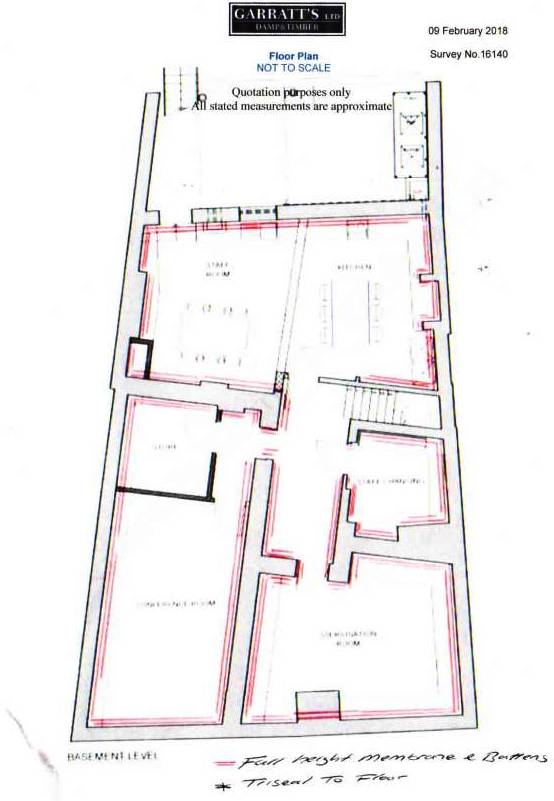
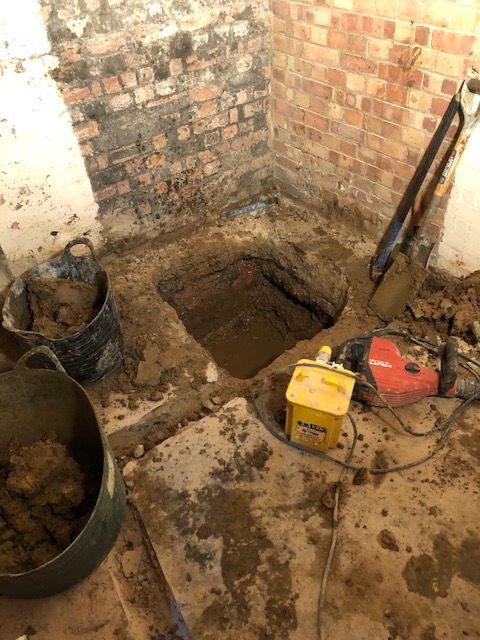
The Ground Works: commenced with floor preparation and the excavation of drainage channels leading to pit to accommodate a sump and pump. This deals with the water ingress we permit behind the high-density polythene (HDPE) membrane. The drainage channels created follow the wall contours and terminate at the sump fitted with a dual battery backed up pumps.
The float activated pump handles water removal from the property to the main external drain. A few additional drainage channels traversed the floor independent of wall positions were required due to the topology.
The beginnings of drainage channels and excavation of pit to house the HDPE sump and pump, essential prerequisites to fitting wall membrane and detailing the floor wall junctions
The picture to the right jumps ahead slightly and shows the same area approaching readiness for handover to the main contractor for final plaster boarding, skimming and decorating. The pump’s water safe power feed can be seen loose fitted near to the provided rodding port that facilitates cleaning of channels for necessary ongoing system maintenance. The sump access plate and epoxy resin floor covering are also visible.

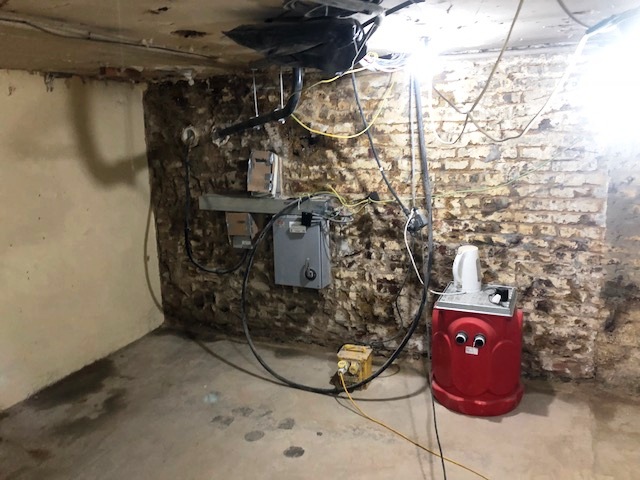
The Walls: were prepared by removing any loose friable material that could become dislodged and potentially block the channels and pump going forward. This area of the basement is waterproofed (with services present) shows poor quality walls taken back to the brickwork, holes for power feeds dubbed in reduced water ingress. The image on the left shows the sump set aside prior to fitting, plus the temporary but essential team kettle can be spotted too.
Another jump ahead image shows the plasterboard being fitted on top of the Type C membrane and timber battens, which is always a pleasing sight to see, marking the light at the end of the tunnel. The floor in this image also includes the epoxy resin sealant on the floor, this damp proofing is applied to protect any client-specified floor coverings used in the final fit of the refurbishment.
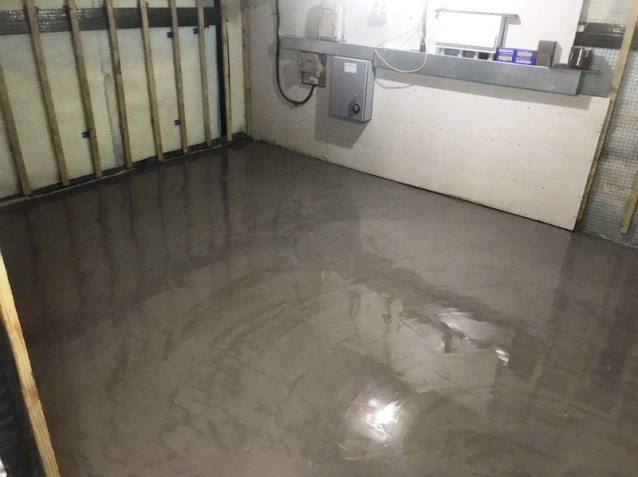
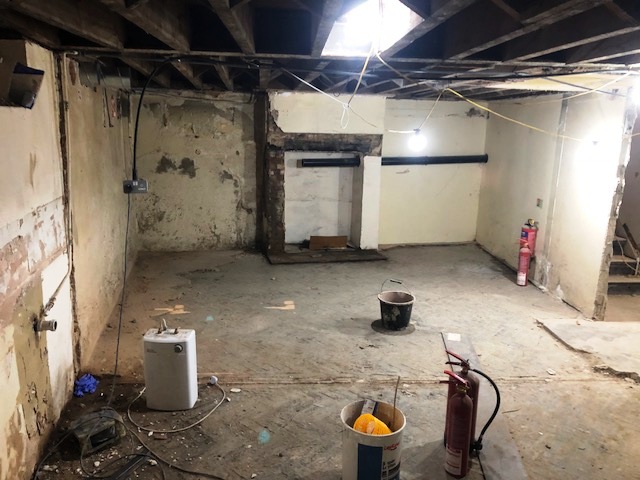
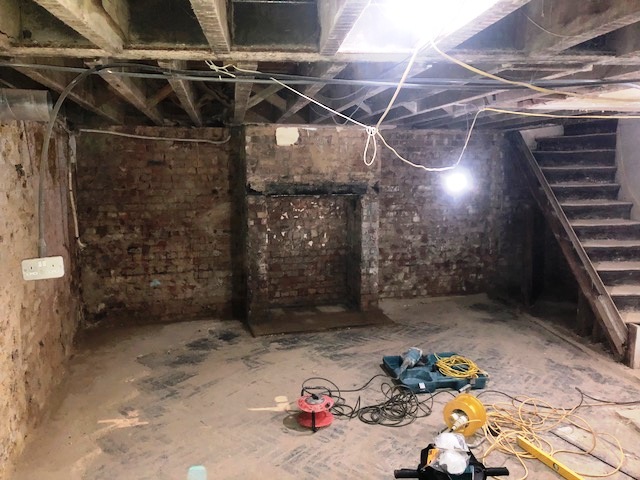
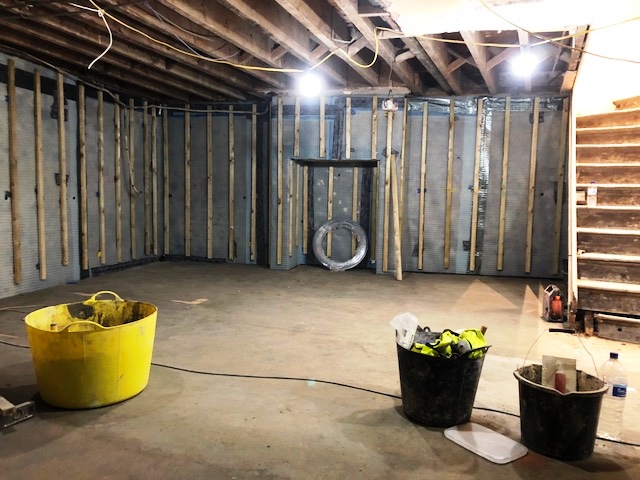
The sheet membrane is fitted to the walls using specialised plastic. All plugs and any joins sealed with proprietary double-sided tape and a final over-tape - all key aspects of BS 8102 Type C waterproofing.
The wall plugs present a hole in order to fit the treated timber battens with screws resulting in a tightly secured framework to take the plasterboard, all of which is on the dry side of the membrane tanking.
The Floors: where friable and cracked were made good with the removal of loose screed and an infill of a tried and tested waterproof cementitious slurry as required. Once this dried sufficiently, a two-part epoxy resin finish was applied in two perpendicular coats with 24 hours drying time between each application.
Water Testing: was conducted in all rooms during initial fitting of the membrane to ensure good drainage along the channels and efficient operation of the automated pumping. This approach is highly desirable prior to finishing works, the main contractor can then sign off our works with confidence.

In Summary: another great collaboration with Garratt’s Damp & Timber Ltd and the main building contractor, with both companies highly satisfied with works, communication and schedule. The detailing with this project was quite straightforward in terms of the floor finish but still as diligently conducted as those requiring new slabs, Type C membrane, insulation and underfloor heating etc.
Whilst we often fit and finish the plaster-boarding when membrane tanking, this was not our remit this time, hence we cannot offer the finalised 2nd fit nor furnished images. We do feel those provided illustrate the quality of our work and the tidiness maintained by our team during the waterproofing process ahead of handover.

The duration of works experienced a daily visit from our works manager and several visits by our surveyors, dependent on who was in the vicinity each day.
Customer service, regular contact and correspondence is a keystone of our work ethic. The images used in this study are also standard practice as client’s often request the before/during/after pictures for their records.
We hope we can offer the same well-rounded and professional service to yourself one day.
Please feel free to call if you wish to discuss basement tanking, rising damp, penetrating damp and any timber treatments such as woodworm, wet rot and dry or condensation issues that may be affecting your property. We offer surveys and advice from our knowledgeable office and team of three roving surveyors with PCA qualifications.
Case Studies
-
2022 British Standards for East London Flooded Basement
The weather in London in 2021 was particularly wet, or so it felt in a property in Leyton, East London,…
-
Bespoke Waterproofing for High-End London Shop Unit
When the basement area of a high-end shop in Chelsea was found to be inches deep in water, one too…
-
Standard Damp Proofing – Windsor SL4
The client instructed Garratt’s to conduct a damp survey and offer considerations related to any remedial works as required. The…
Archived Case Study
Recent
-
18 Mar 2024
How to Get Rid of Damp in Bedrooms
While it may seem more logical that kitchens and bathrooms are more prone to damp, it may be surprising for…
-
13 Nov 2023
Benefits of Tanking Your Basement
While basements have been a staple of home construction in multiple countries, they are still a relatively new concept in…
-
13 Nov 2023
Taking Action on Fixing Damp
Damp is a widespread problem in properties across the UK; however, this doesn’t stop the fact that it’s a serious…







